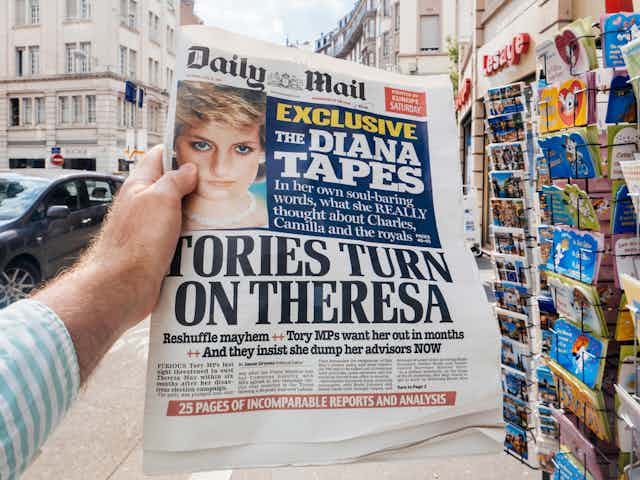In the aftermath of the UK elections, there has been much speculation that the power of the Tory supporting tabloids is on the wane, diminished by social media and a youth surge to the left. This would be a very sudden demise. After all, it was those very same tabloids that, just a year ago, were credited with pulling off their greatest political coup by convincing large numbers of their working-class readers to vote Brexit.
A closer look at the analysis of exit polls, media coverage and Twitter hashtags tell a rather more complicated story. Analysis in the Financial Times, using a number of different exit polls, finds that the question of Brexit was the biggest factor for 70% of those people voting Conservative. And just as expected, the Conservatives did indeed make inroads into Labour territory in the Brexit-leaning constituencies of the North. These are the places the tabloids call home. Their key win was in the ex-mining town of Mansfield in Nottinghamshire, where nearly 71% of people voted Leave, and which the Conservatives took with an 18% swing by just over 1,000 votes.
Such Conservative swings were not enough to deliver many knockout blows in heavily Labour-supporting areas – but they do show a direction of travel. Poverty, poor health and a sense of powerlessness seem to have favoured poll swings to the Tories, while the young and issues around education favoured Labour. This was not just a newly energised student vote (though that certainly helped), the surge to Labour was high among anyone younger than 45. The biggest swings towards Labour were seen in multi-ethnic neighbourhoods with younger populations and higher levels of education. This is a demographic that is currently under-served by all British print media, not just the red tops.
To be sure, the right-wing tabloids called the election wrong – but they have been on the wrong side of history in the past. In 1997, when the Conservatives were last imploding over Europe and were totally out of step with cultural change, it was only The Sun that felt which way the wind was blowing.
Murdoch managed to get behind Labour just in time to catch the Labour landslide. Had he not switched direction, the “Soaraway Sun” would have looked as out of touch then as its front page did on election day last week when it was the only tabloid to feature an anti-Corbyn front page. The others were all strangely muted. They supported May but without the strident conviction that had won the Brexit vote.
May feels the heat
The red tops did nothing to help Corbyn win but they may well have been responsible for May’s losses. Far from attacking Corbyn and supporting the Conservatives, according to Loughborough University’s content analysis, the newspapers almost all changed direction halfway through the campaign. The number of anti-Corbyn stories dropped in the second fortnight and the number of stories critical of Theresa May soared.
This was a direct response to the publication of the Conservative manifesto, which contained pledges that would negatively affect the elderly and people who own their own home. These newspapers are commercial operations – they may have political axes to grind but, in straightened times, they also need readers and May was clearly attacking the very home-owning, hard-working families that they depend on.

Not every editor changed tack. The Daily Mail stuck with May, just as in 1997 it stuck with the Tories. The Labour win didn’t stop the paper then and it is unlikely to dent its confidence now. It is the largest circulation newspaper online, with 15m daily browsers, and only just behind The Sun offline with a print circulation of 1.5m. It may be bruised by its support for May, but it remains unbowed.
Nothing for young eyes
Talk of the end of the tabloids assumes that millions of young voters are consuming material from a variety of new information sources. But social media is mainly a means of distributing material and comment on stories that have been produced by existing, mainstream news sources and by political parties (propaganda). It functions by separating audiences into tightly bound groups, all cheerleading for the same cause – Daily Mail stories, which are optimised for sharing, slip easily into the right-wing social media bubble they helped to create around the EU referendum.
It is hard to analyse what is happening on Facebook without access to secret Facebook data, but Twitter is more transparent. A study of Twitter links by academics at Oxford University, during the election period, found that Labour was the main subject of Twitter conversation.
During the referendum, however, pro-Brexit discussions predominated and the most-shared post came from the Daily Express. The Oxford research also found that 56% of relevant pre-election content shared on Twitter came from professional sources. The BBC predominantly, followed by The Guardian. Junk news also figured, as did links generated automatically by Bots – which also favoured Labour.
But the predominance of The Guardian on Twitter may turn out to be a mixed blessing for the news organisation as many of the links may have negatively framed Guardian articles. The newspaper did change course and backed Labour at the last minute, but Corbyn supporters are still furious at the attacks on their leader over the past two years. Indeed, it could be argued that it is The Guardian that has had the tin ear when it comes to hearing the needs of its readers.
Even Corbyn’s detractors (disclosure: I was one of them) couldn’t fail to feel uneasy about the way in which The Guardian blindly followed the right-wing news agenda – helping to demonise, rather than understand. If there is something missing in the UK media scene, it is a serious news organisation that fulfils the needs of the vast army of ethnically-mixed under-45s who saw something positive in a Labour manifesto that dared to put them first.

